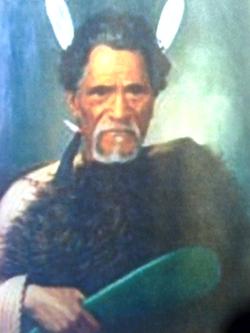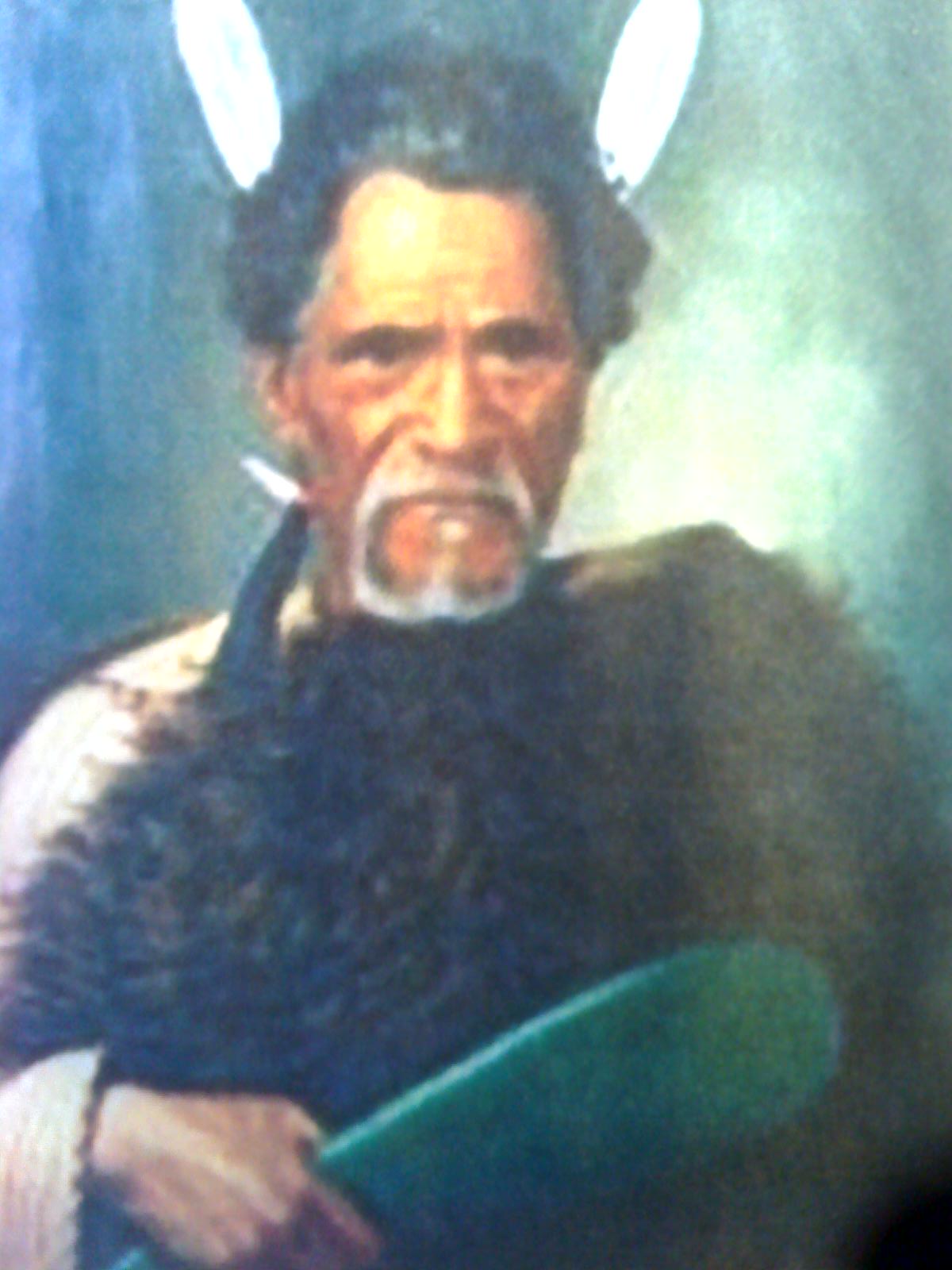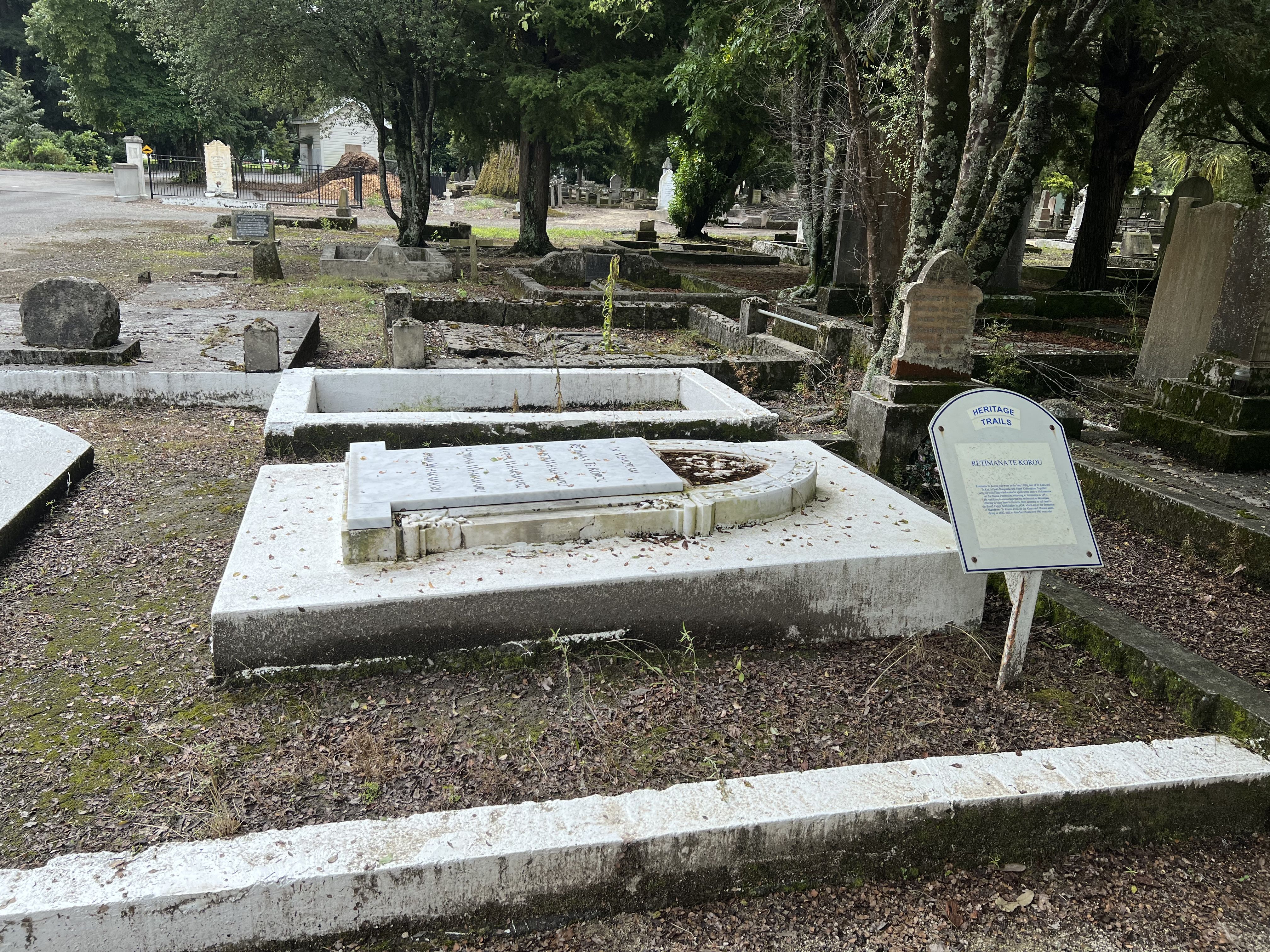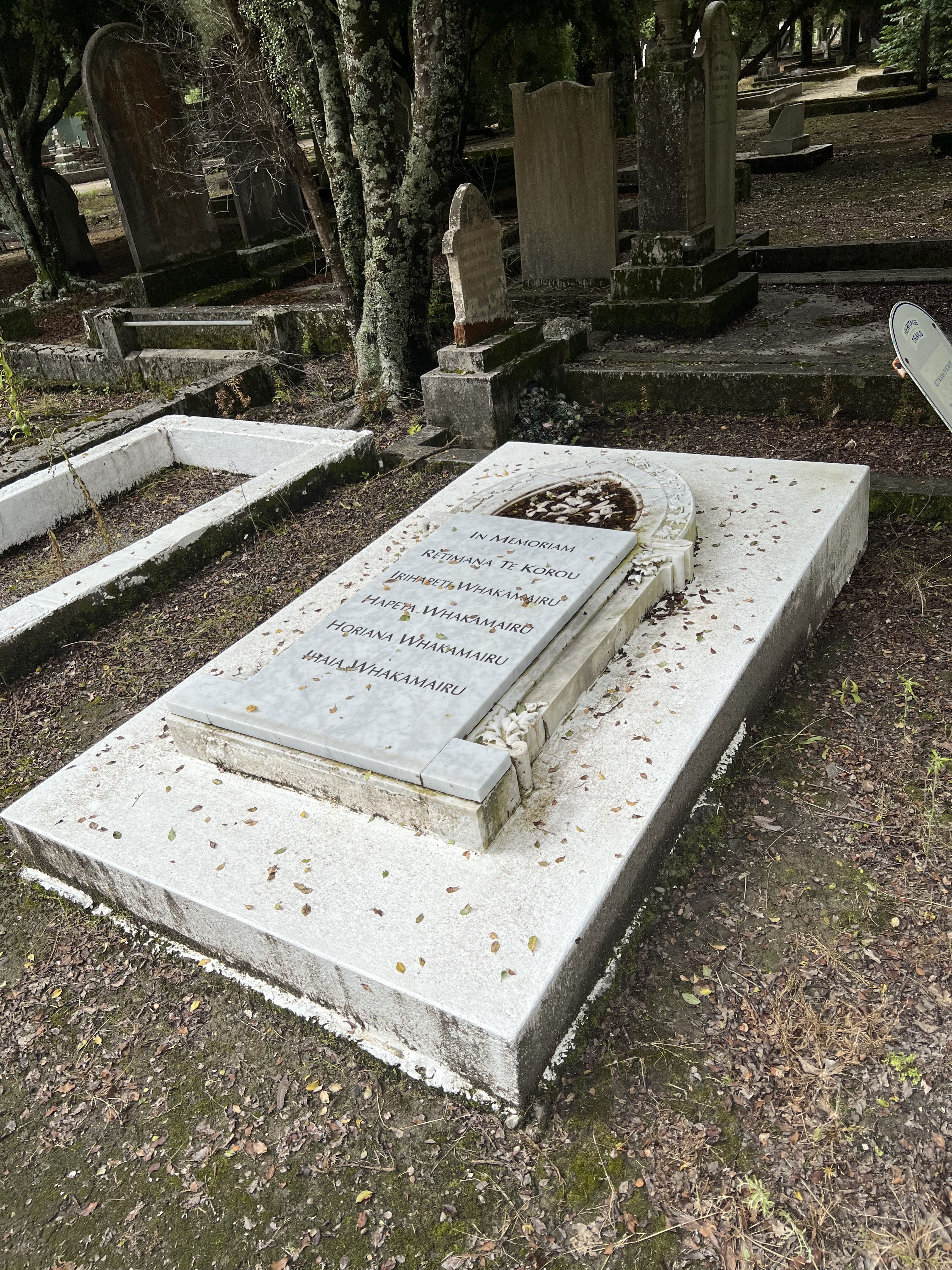He was Rangitane chief, Te Retimona Te Korou with Joseph Masters set up the Small Farm Association and established the town of Masterton ...
He married Hoana (later Joan) Hinewhakaaea c1825
Retimana Te Korou, the principal Maori chief involved in the sale of the land for the township of Masterton, was born in the later years of the eighteenth century. He was the son of Te Raku and Te Kai from both Rangitane and Ngati Kahungunu peoples of Wairarapa.
Te Korou was among those whose life was severely disrupted following the displacements of peoples during the Musket Wars. Some Taranaki iwi who came to the Wellington area with Te Rauparaha, pushed their way eastwards, and some were living in Wairarapa. At first they lived alongside the Kahungunu and Rangitane iwi, but troubles eventually arose and a series of battles were fought between the two groups.
Some battles went well for the locals, but there were bad setbacks too, with some fights lost and warriors captured, including Te Korou. Te Wera of Ngati Mutunga was taking him to Wellington when he escaped by killing him. Realising it was no longer safe in Wairarapa, Te Korou, his wife Hine-whaka-aea, and their children joined other Wairarapa Maori at the stronghold of Nukutaurua, on Mahia Peninsular, where they remained until 1841.
Te Korou returned home, firstly as part of a group of Wairarapa chiefs that made peace with Taranaki Maori still living in Wellington, then on his family's ancestral lands. When the missionary William Colenso called in to Kaikokirikiri pa, on the banks of the Waipoua River above what was to become Masterton, a Maori teacher had already converted Te Korou to Christianity. Te Korou's family was all baptised and they adopted new names. Te Korou chose Retimana (Richmond); his wife became Hoana (Joan) and his surviving children Erihapeti (Elizabeth) and Karaitiana (Christian).
It was at the nearby Ngaumutawa kainga that members of the Small Farms Association met with Te Korou and his family and after consultation it was decided his son-in-law Ihaiah Whakamairu should return with the members, to start arrangements for the sale. Retimana did not sign the eventual deed, although he did sign to others around Masterton. His family's names appear on the document however: Karaitiana, Erihapeti and Ihaiah.
By the 1860s Retimana seems to have ceded leadership of his hapu to his son Karaitiana and his son-in-law Ihaiah. Both father and son became supporters of the King movement in the turbulent years ahead, and Karaitiana spent some time away from Wairarapa, fighting on the west coast. In time Te Korou became reconciled with his pakeha neighbours, and on his death in 1882, many of Masterton's leading settlers joined in the 300-strong cortege that made its way to his burial place, in the Masterton Cemetery.
Through his father, Te Raku, he was a descendant of Rangitāne, from Hauiti, the younger sibling of Hamua, ancestor of his principal hapū. His mother was Te Kai, and through her he was descended from Te Awariki, the youngest of the three brothers descended from Rangitāne. He was, by 1840, married to Hinewhakaaea. She was descended from Te Hina-ariki, ancestor of Ngāti Te Hina, and was connected with Wairarapa Ngāi Tahu. Te Korou and his family were also connected with Ngāti Wheke, Te Matehau, Ngāti Te Hauaitū, Ngāti Te Tohinga, Ngāti Te Umu and Ngāti Te Aomatauru. Through extensive intermarriage the family was related to Ngāti Kahungunu, but their chief kinship was with Rangitāne.
Te Korou and his family were among those who about 1834 were forced to flee from Wairarapa to Nukutaurua on the Māhia peninsula by the invasion of northern tribes. Te Korou was captured by Te Ati Awa, but he escaped near Ōrongorongo after tricking one of his captors, Te Wera of Ngāti Mutunga. When no one else was near, Te Korou offered to rearrange Te Wera's load, seized his long-handled tomahawk, gashed Te Wera's hands which he had put up to protect himself, killed him, and escaped into the bush. When peace was arranged between the Wairarapa people and the invaders Te Korou was among the negotiators. Ngāti Kahungunu, Rangitāne and other tribes returned from the north from 1841 on, and Te Korou, already past middle age, re-established his position as one of the principal leaders in Northern Wairarapa. His interests and influence extended from present day Masterton to Eketāhuna, and from the Tararua range eastwards to the coast.
In the 1840s Te Korou and his family were drawn towards Christianity. By the time he had been forced to go north, he had three children: a daughter, Erihāpeti (Elizabeth); a son, Te Tua-o-te-rangi (or Te Turuki, later known by his baptismal name, Karaitiana or Christian); and a third, probably another son. When the missionary William Colenso visited Te Korou at Kaikōkirikiri, near present day Masterton, he found Erihapeti about to be married to Īhāia Whakamairu. Since 1845 the whole community at Kaikōkirikiri had been under the influence of a Christian teacher, Campbell Hāwea, and in 1848 Colenso was happy to baptise all four Te Korou generations: Te Korou himself, who took the name Te Retimana (Richmond); his aged mother Te Kai who took the name Roihi (Lois); his wife Hinewhakaaewa, who became Hoana (Joan/Joanna); his daughter, Erihāpeti, and her husband, Īhāia Whakamairu; his four sons (two of them still boys); and two grandsons. Colenso noted that Karaitiana was a 'fine youth' and a fluent reader of the Bible in Māori.
Colenso recorded that Te Korou was determined to preserve his lands for his children, and to prevent his family from being demoralised by contact with Pākehā. But he was unable to live up to this hope. Already, in 1844, he had tried to lease land in the Whareama valley to the runholders Charles Clifford, Frederick Weld and William Vavasour, and had been annoyed when they decided to seek drier pasturage further north. In 1848 Te Korou was among those who discussed with Francis Dillon Bell, the New Zealand Company agent, the possible sale of Wairarapa land for the proposed 'Canterbury settlement', later sited in the South Island. Te Korou took part in other transactions; his willingness to do so probably arose from the fact that others were leasing lands in which he had an interest, without consulting him. There was argument in Kaikōkirikiri over the leasing of the Manaia block to W. B. Rhodes and W. H. Donald. Later Te Korou proved to be one of the most co-operative in land negotiations with Henry Tacy Kemp.
As Pākehā settlement penetrated Wairarapa, tensions grew between younger men wishing to sell land, and their leading elders, who at first preferred to lease. However, to preserve something for themselves from the maelstrom of land-selling the older chiefs, whose mana would earlier have gone unchallenged, became sellers themselves. It is likely that on the one hand Te Korou, and on the other his son Karaitiana and his son-in-law Īhāia Whakamairu, were caught up in this kind of rivalry.
The pressure which Te Korou had to face came from the Small Farm Association, a body seeking to settle farmers on small land-holdings. The association sent Joseph Masters (after whom Masterton was to be named) and H. H. Jackson to Kaikōkirikiri, at Governor George Grey's suggestion. Their arguments were persuasive; Īhāia Whakamairu returned with them to Wellington to complete the sale. There is no record that Te Korou objected to the sale, but the sellers included some of the younger members of his family. In the various transactions which transferred the site of Masterton to the Crown, the names of Karaitiana, Eriāapeti and Īhāia Whakamairu are prominent. Te Korou was directly involved in a number of sales, mainly to the south and east of Masterton, in the Maungaraki, Wainuioru and Whareama districts. He also signed the Castlepoint deed. Both he and Karaitiana sold parts of the same blocks together, but for the most part they did business separately.
From the 1860s on Karaitiana appears to have taken over from his father; at the 1860 Kohimarama conference he represented Kaikōkirikiri. From the beginning of Native Land Court sittings in the Wairarapa in 1866 Karaitiana and Erihapeti represented the interests of the family. Te Korou did not appear often; in 1868 he was described as 'an old man of Ngāti Wheke'. Both father and son are described in government documents as supporters of the King movement in 1862. But they, with other Wairarapa leaders, were adherents more because of dissatisfaction over land sales and payments than because of any special attachment to the King.
Te Retimana Te Korou was said to be over 100 when he died at Manaia in early January 1882. Īhāia Whakamairu invited all his European friends to join in the mourning. Several leading settlers joined in a procession of 300 people to the Masterton cemetery.
DEATH Yesterday morning one of the oldest Maoris in this district breathed his last at Manaia, near Masterton. His name was Retimana Te Korou and his age is stated to be over 100 years. At one time the deceased chief owned all the land upon which Masterton now stands and in his youth was a gallant warrior. Forty years ago he became a Christian and has ever since been a peaceful subject of the Queen. The well-known chief, Ihaia Whakamairu, invites by advertisement in another column all old European friends to meet at the Royal Hotel, Masterton, on Monday next at 2 o'clock to follow to the grave the remains of the departed loyal chief, which will be interred in the Masterton Cemetery, in accordance with his last wish. As the deceased was well-known to old settlers, there will no doubt be a large fathering to do honor to his funeral.
Wairarapa Daily Times, 13 March 1882
FUNERAL Of Te Retimana Te Korou In response to the invitation published on Saturday, a large number of white people and Maoris assembled to do honor to the remains of the above loyal chief. The procession started from the Royal Hotel and consisted of nearly 300 followers, male and female on foot, in vehicles and on horseback. A very large concourse accompanied it on the footpaths on either side. The cortege was well marshalled by Mr Jago, assisted by a native friend of the deceased. On reaching the Church the coffin was carried in by four Europeans, the service being impressively conducted in Maori by the Rev W. E. Page, assisted by the native Minister of Te Ore ore. After service in the Church the procession re-formed and marched to the Masterton Cemetery, where the remains were lowered to their final resting place in the Church of England portion of the ground. Two chief mourners were extremely old native women, who supported their tottering steps by clinging to the back of the hearse. These were followed by Ihaia Whakamairu and other well-known chiefs, while among the European followers were Messrs Beetham and Buchanan, M.H.R.'s, J. V. Smith and several leading settlers.
He was Rangitane chief, Te Retimona Te Korou with Joseph Masters set up the Small Farm Association and established the town of Masterton ...
He married Hoana (later Joan) Hinewhakaaea c1825
Retimana Te Korou, the principal Maori chief involved in the sale of the land for the township of Masterton, was born in the later years of the eighteenth century. He was the son of Te Raku and Te Kai from both Rangitane and Ngati Kahungunu peoples of Wairarapa.
Te Korou was among those whose life was severely disrupted following the displacements of peoples during the Musket Wars. Some Taranaki iwi who came to the Wellington area with Te Rauparaha, pushed their way eastwards, and some were living in Wairarapa. At first they lived alongside the Kahungunu and Rangitane iwi, but troubles eventually arose and a series of battles were fought between the two groups.
Some battles went well for the locals, but there were bad setbacks too, with some fights lost and warriors captured, including Te Korou. Te Wera of Ngati Mutunga was taking him to Wellington when he escaped by killing him. Realising it was no longer safe in Wairarapa, Te Korou, his wife Hine-whaka-aea, and their children joined other Wairarapa Maori at the stronghold of Nukutaurua, on Mahia Peninsular, where they remained until 1841.
Te Korou returned home, firstly as part of a group of Wairarapa chiefs that made peace with Taranaki Maori still living in Wellington, then on his family's ancestral lands. When the missionary William Colenso called in to Kaikokirikiri pa, on the banks of the Waipoua River above what was to become Masterton, a Maori teacher had already converted Te Korou to Christianity. Te Korou's family was all baptised and they adopted new names. Te Korou chose Retimana (Richmond); his wife became Hoana (Joan) and his surviving children Erihapeti (Elizabeth) and Karaitiana (Christian).
It was at the nearby Ngaumutawa kainga that members of the Small Farms Association met with Te Korou and his family and after consultation it was decided his son-in-law Ihaiah Whakamairu should return with the members, to start arrangements for the sale. Retimana did not sign the eventual deed, although he did sign to others around Masterton. His family's names appear on the document however: Karaitiana, Erihapeti and Ihaiah.
By the 1860s Retimana seems to have ceded leadership of his hapu to his son Karaitiana and his son-in-law Ihaiah. Both father and son became supporters of the King movement in the turbulent years ahead, and Karaitiana spent some time away from Wairarapa, fighting on the west coast. In time Te Korou became reconciled with his pakeha neighbours, and on his death in 1882, many of Masterton's leading settlers joined in the 300-strong cortege that made its way to his burial place, in the Masterton Cemetery.
Through his father, Te Raku, he was a descendant of Rangitāne, from Hauiti, the younger sibling of Hamua, ancestor of his principal hapū. His mother was Te Kai, and through her he was descended from Te Awariki, the youngest of the three brothers descended from Rangitāne. He was, by 1840, married to Hinewhakaaea. She was descended from Te Hina-ariki, ancestor of Ngāti Te Hina, and was connected with Wairarapa Ngāi Tahu. Te Korou and his family were also connected with Ngāti Wheke, Te Matehau, Ngāti Te Hauaitū, Ngāti Te Tohinga, Ngāti Te Umu and Ngāti Te Aomatauru. Through extensive intermarriage the family was related to Ngāti Kahungunu, but their chief kinship was with Rangitāne.
Te Korou and his family were among those who about 1834 were forced to flee from Wairarapa to Nukutaurua on the Māhia peninsula by the invasion of northern tribes. Te Korou was captured by Te Ati Awa, but he escaped near Ōrongorongo after tricking one of his captors, Te Wera of Ngāti Mutunga. When no one else was near, Te Korou offered to rearrange Te Wera's load, seized his long-handled tomahawk, gashed Te Wera's hands which he had put up to protect himself, killed him, and escaped into the bush. When peace was arranged between the Wairarapa people and the invaders Te Korou was among the negotiators. Ngāti Kahungunu, Rangitāne and other tribes returned from the north from 1841 on, and Te Korou, already past middle age, re-established his position as one of the principal leaders in Northern Wairarapa. His interests and influence extended from present day Masterton to Eketāhuna, and from the Tararua range eastwards to the coast.
In the 1840s Te Korou and his family were drawn towards Christianity. By the time he had been forced to go north, he had three children: a daughter, Erihāpeti (Elizabeth); a son, Te Tua-o-te-rangi (or Te Turuki, later known by his baptismal name, Karaitiana or Christian); and a third, probably another son. When the missionary William Colenso visited Te Korou at Kaikōkirikiri, near present day Masterton, he found Erihapeti about to be married to Īhāia Whakamairu. Since 1845 the whole community at Kaikōkirikiri had been under the influence of a Christian teacher, Campbell Hāwea, and in 1848 Colenso was happy to baptise all four Te Korou generations: Te Korou himself, who took the name Te Retimana (Richmond); his aged mother Te Kai who took the name Roihi (Lois); his wife Hinewhakaaewa, who became Hoana (Joan/Joanna); his daughter, Erihāpeti, and her husband, Īhāia Whakamairu; his four sons (two of them still boys); and two grandsons. Colenso noted that Karaitiana was a 'fine youth' and a fluent reader of the Bible in Māori.
Colenso recorded that Te Korou was determined to preserve his lands for his children, and to prevent his family from being demoralised by contact with Pākehā. But he was unable to live up to this hope. Already, in 1844, he had tried to lease land in the Whareama valley to the runholders Charles Clifford, Frederick Weld and William Vavasour, and had been annoyed when they decided to seek drier pasturage further north. In 1848 Te Korou was among those who discussed with Francis Dillon Bell, the New Zealand Company agent, the possible sale of Wairarapa land for the proposed 'Canterbury settlement', later sited in the South Island. Te Korou took part in other transactions; his willingness to do so probably arose from the fact that others were leasing lands in which he had an interest, without consulting him. There was argument in Kaikōkirikiri over the leasing of the Manaia block to W. B. Rhodes and W. H. Donald. Later Te Korou proved to be one of the most co-operative in land negotiations with Henry Tacy Kemp.
As Pākehā settlement penetrated Wairarapa, tensions grew between younger men wishing to sell land, and their leading elders, who at first preferred to lease. However, to preserve something for themselves from the maelstrom of land-selling the older chiefs, whose mana would earlier have gone unchallenged, became sellers themselves. It is likely that on the one hand Te Korou, and on the other his son Karaitiana and his son-in-law Īhāia Whakamairu, were caught up in this kind of rivalry.
The pressure which Te Korou had to face came from the Small Farm Association, a body seeking to settle farmers on small land-holdings. The association sent Joseph Masters (after whom Masterton was to be named) and H. H. Jackson to Kaikōkirikiri, at Governor George Grey's suggestion. Their arguments were persuasive; Īhāia Whakamairu returned with them to Wellington to complete the sale. There is no record that Te Korou objected to the sale, but the sellers included some of the younger members of his family. In the various transactions which transferred the site of Masterton to the Crown, the names of Karaitiana, Eriāapeti and Īhāia Whakamairu are prominent. Te Korou was directly involved in a number of sales, mainly to the south and east of Masterton, in the Maungaraki, Wainuioru and Whareama districts. He also signed the Castlepoint deed. Both he and Karaitiana sold parts of the same blocks together, but for the most part they did business separately.
From the 1860s on Karaitiana appears to have taken over from his father; at the 1860 Kohimarama conference he represented Kaikōkirikiri. From the beginning of Native Land Court sittings in the Wairarapa in 1866 Karaitiana and Erihapeti represented the interests of the family. Te Korou did not appear often; in 1868 he was described as 'an old man of Ngāti Wheke'. Both father and son are described in government documents as supporters of the King movement in 1862. But they, with other Wairarapa leaders, were adherents more because of dissatisfaction over land sales and payments than because of any special attachment to the King.
Te Retimana Te Korou was said to be over 100 when he died at Manaia in early January 1882. Īhāia Whakamairu invited all his European friends to join in the mourning. Several leading settlers joined in a procession of 300 people to the Masterton cemetery.
DEATH Yesterday morning one of the oldest Maoris in this district breathed his last at Manaia, near Masterton. His name was Retimana Te Korou and his age is stated to be over 100 years. At one time the deceased chief owned all the land upon which Masterton now stands and in his youth was a gallant warrior. Forty years ago he became a Christian and has ever since been a peaceful subject of the Queen. The well-known chief, Ihaia Whakamairu, invites by advertisement in another column all old European friends to meet at the Royal Hotel, Masterton, on Monday next at 2 o'clock to follow to the grave the remains of the departed loyal chief, which will be interred in the Masterton Cemetery, in accordance with his last wish. As the deceased was well-known to old settlers, there will no doubt be a large fathering to do honor to his funeral.
Wairarapa Daily Times, 13 March 1882
FUNERAL Of Te Retimana Te Korou In response to the invitation published on Saturday, a large number of white people and Maoris assembled to do honor to the remains of the above loyal chief. The procession started from the Royal Hotel and consisted of nearly 300 followers, male and female on foot, in vehicles and on horseback. A very large concourse accompanied it on the footpaths on either side. The cortege was well marshalled by Mr Jago, assisted by a native friend of the deceased. On reaching the Church the coffin was carried in by four Europeans, the service being impressively conducted in Maori by the Rev W. E. Page, assisted by the native Minister of Te Ore ore. After service in the Church the procession re-formed and marched to the Masterton Cemetery, where the remains were lowered to their final resting place in the Church of England portion of the ground. Two chief mourners were extremely old native women, who supported their tottering steps by clinging to the back of the hearse. These were followed by Ihaia Whakamairu and other well-known chiefs, while among the European followers were Messrs Beetham and Buchanan, M.H.R.'s, J. V. Smith and several leading settlers.
Family Members
Advertisement
Advertisement




